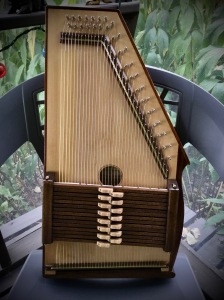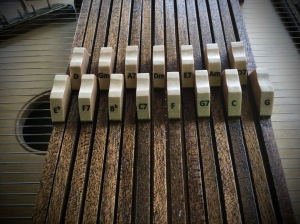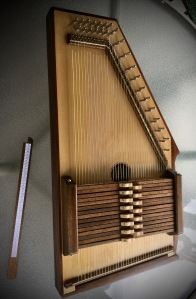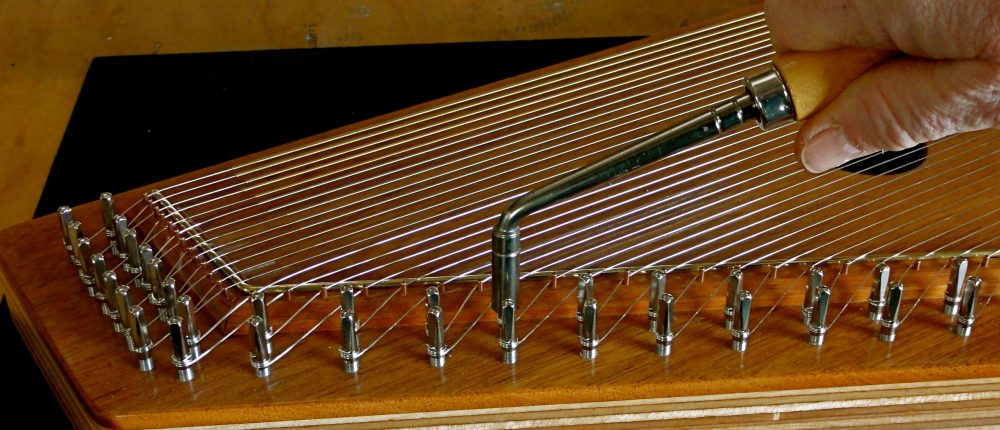 A musician from Tennessee recently commissioned this custom autoharp with several features that, to me, are very similar to the fifteen chord Oscar Schmidt and ChromaHarp models of the past. Over the years those A style chromatic models with their round sound holes, fifteen chord bars in two rows, and laminated soundboards underwent many improvements by their manufacturers. This musician seems to favor that style of instrument and was able to specify several construction, setup, and cosmetic improvements to suit his preferences and playing style.
A musician from Tennessee recently commissioned this custom autoharp with several features that, to me, are very similar to the fifteen chord Oscar Schmidt and ChromaHarp models of the past. Over the years those A style chromatic models with their round sound holes, fifteen chord bars in two rows, and laminated soundboards underwent many improvements by their manufacturers. This musician seems to favor that style of instrument and was able to specify several construction, setup, and cosmetic improvements to suit his preferences and playing style.
 Most of my builds have been set up for playing in the area above the chord bars with the high treble strings unobstructed by the chord bar covers. This chord set is positioned closer to the tuning pins to permit play below the chord bars at the anchor end. Many of the old OS A models were arranged this way until playing the instrument upright became common and the bar set was moved south by their owners or the factories. This instrument is designed to be played on the musician’s lap with the left hand at the chords and the right hand playing near the anchor bridge.
Most of my builds have been set up for playing in the area above the chord bars with the high treble strings unobstructed by the chord bar covers. This chord set is positioned closer to the tuning pins to permit play below the chord bars at the anchor end. Many of the old OS A models were arranged this way until playing the instrument upright became common and the bar set was moved south by their owners or the factories. This instrument is designed to be played on the musician’s lap with the left hand at the chords and the right hand playing near the anchor bridge.
 The old A models chord bars and buttons were 5/16 inches wide. I reduced these bars to a 1/4 inch width to narrow the array while leaving the buttons wide enough as to not require caps. The maple buttons are of a similar style to the older fifteen chord ‘harps and the chords are selected and arranged to the musician’s preference. He prefers a higher action (the height of the felt above the strings) for more vigorous chording. I set the travel high as requested but included extra self-sticking felt strips for under the covers should he choose to adjust the bars lower.
The old A models chord bars and buttons were 5/16 inches wide. I reduced these bars to a 1/4 inch width to narrow the array while leaving the buttons wide enough as to not require caps. The maple buttons are of a similar style to the older fifteen chord ‘harps and the chords are selected and arranged to the musician’s preference. He prefers a higher action (the height of the felt above the strings) for more vigorous chording. I set the travel high as requested but included extra self-sticking felt strips for under the covers should he choose to adjust the bars lower.
 The modern improvements in the construction of this instrument include a solid spruce soundboard with tuned bracing, a one piece laminated frame, and quiet chord bars mounted on Delrin and steel pin combs. The chord bars, covers, side veneer, bridges, and tailpiece are made of African mahogany that has been stained dark brown. The musician requested that I not apply note labels under the tuning pins so I included a wooden tuning strip/duster that can be positioned under the strings to aid tuning.
The modern improvements in the construction of this instrument include a solid spruce soundboard with tuned bracing, a one piece laminated frame, and quiet chord bars mounted on Delrin and steel pin combs. The chord bars, covers, side veneer, bridges, and tailpiece are made of African mahogany that has been stained dark brown. The musician requested that I not apply note labels under the tuning pins so I included a wooden tuning strip/duster that can be positioned under the strings to aid tuning.
 A custom built autoharp such as this can be built with the preferred features and options that improve playability and appearance. Sometimes it comes with a surprise: as the owner noted, “I was in shock at how light it is!”.
A custom built autoharp such as this can be built with the preferred features and options that improve playability and appearance. Sometimes it comes with a surprise: as the owner noted, “I was in shock at how light it is!”.

You must be logged in to post a comment.